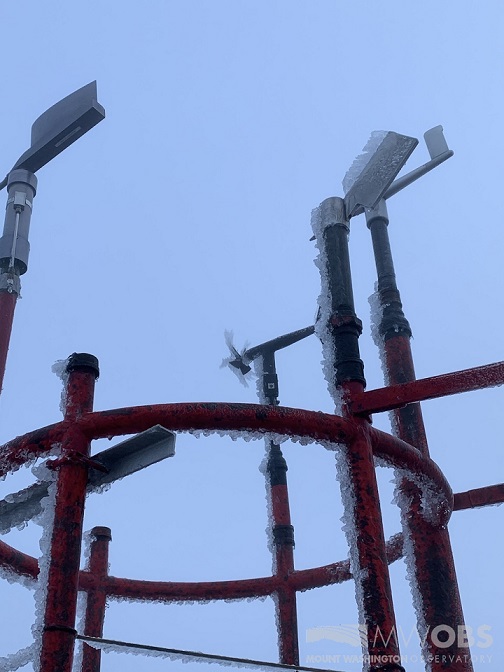Types of Icing Events on Mount Washington
2019-09-17 14:23:48.000 – Ben Charles, Intern
The second week of my fall internship here at the summit of Mount Washington has been an eventful one. It had been since my first shift on the mountain back in late May since I have seen sub-freezing temperatures on the summit, but we were lucky enough to see temperatures dip below the freezing mark twice last Thursday and Friday! However, we were in the clear both times we got below freezing so we didn’t see much freezing other than some surplus trail runoff. Yesterday was a different story, I was in a deep slumber in my room and woke up to a rather loud clanking sound. I immediately knew that we must have gotten below freezing and it had to be our night observer Jay deicing the instruments on top of the tower. So I jumped out of bed to see my first rime ice event which I have been waiting oh so very patiently for. When I got up to the weather room and looked out the window, through the fog I didn’t see the white brittle rime ice covering the rocks, but was surprised to see a glossy coat of glaze ice. But what is Glaze ice?
Glaze ice unlike rime ice is very dense and looks and is very similar to the ice that forms when there is freezing rain typically being smooth with a waxy appearance. Freezing rain can create a glaze of ice, but the ice we received yesterday was from a cloud. Glaze ice and rime ice can both form in the same way. Both can form from supercooled water droplets inside of a cloud colliding with an object and freezing, and in this case the object is the summit of Mount Washington. The stronger the winds the more supercooled water droplets that will collide into the summit resulting in increasing accumulations.
To start rime ice forms when temperatures are well below freezing and when the supercooled water droplets are rather small most likely to be seen in a stratiform cloud. Upon impact, the surface must be well below 32°F letting the supercooled droplet to instantly freeze without spreading from the point of impact. The instantaneous freezing of rime ice allows the drop to keep their spherical shape causing air pockets to remain within the ice. This gives rime ice that opaque look and brittle consistency. This is also another type of rime ice called hard rime ice which is denser than normal rime ice. This is because it has less supercooled droplets and more ice crystals within the cloud.
Glaze ice will form in a very similar fashion although in warmer temperatures just below freezing. Typically with warmer temperatures, the air can hold a bit more moisture allowing for the supercooled droplets to have larger diameters these drops are more likely in cumuliform clouds. So when the supercooled drops are rather larger, they must impact a surface that is only a few degrees below freezing or right at the freezing mark. This way when the supercooled drops hit the surface the entire drop won’t immediately freeze, the majority of the drop will disperse and spread across the surface. Then after dispersing it will eventually freeze giving it the glossy smooth surface with no air pockets within the ice.

Ben Charles, Intern
Team Flags Return for Seek the Peak’s 25th Anniversary
Team Flags Return for Seek the Peak's 25th Anniversary By MWOBS Staff Mount Washington Observatory is looking forward to continuing a much-loved tradition for Seek the Peak’s 25th Anniversary: Team flags. In inviting teams
Meet Summer Interns Zakiya, Max and Maddie
Meet Summer Interns Zakiya, Max and Maddie By MWOBS Staff We are excited to welcome six teammates to the summit of Mount Washington this summer! During their internship, these students and graduates will play
Saying Goodbye to the Summit
Saying Goodbye to the Summit By Alexis George After an extraordinary last three years working as a Weather Observer and Meteorologist, I am excited to pursue a different career. As sad I as am




